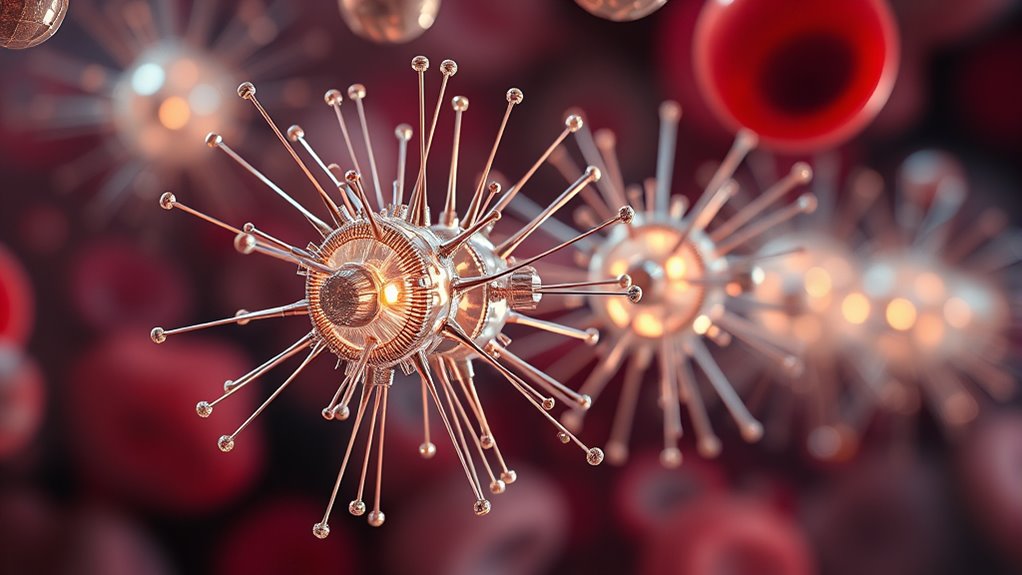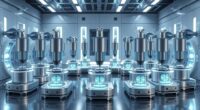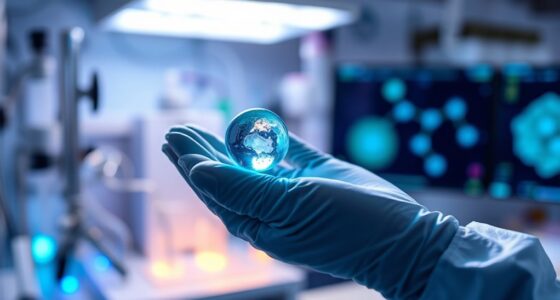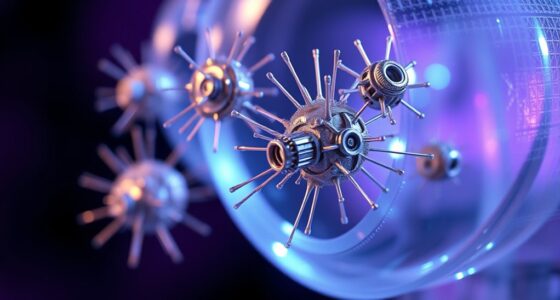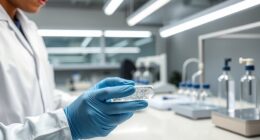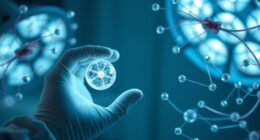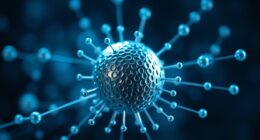Nanomedicine employs tiny machines called nanomachines that interact with cells and molecules in your body. These devices can diagnose diseases early, deliver drugs precisely where needed, and perform microsurgeries. They come in forms like nanoparticles, nanorobots, and molecular machines, offering safer, more effective treatments. While promising, safety and biocompatibility are essential concerns. Exploring further reveals how these innovations are transforming healthcare and shaping the future of medicine.
Key Takeaways
- Nanomachines in healthcare operate at nanoscale to facilitate targeted diagnosis, drug delivery, and microsurgeries with high precision.
- They encompass various types like nanorobots, nanoparticles, and molecular machines, each designed for specific medical tasks.
- Nanotechnology enhances early disease detection and imaging through advanced tools such as quantum dots and nanosensors.
- Safety concerns include biocompatibility, toxicity, and long-term accumulation, requiring rigorous testing and regulatory guidelines.
- Future nanomedicine aims for personalized, minimally invasive treatments, integrating AI, biodegradable materials, and regenerative therapies.
Fundamentals of Nanomachines in Medicine
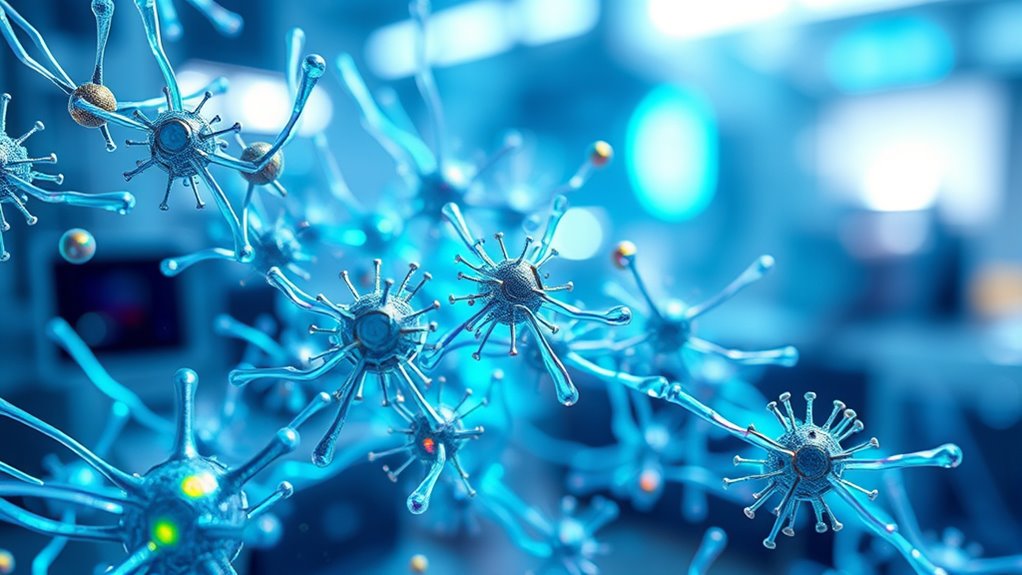
Nanomachines are tiny devices designed to perform specific tasks at the molecular level, revolutionizing medicine by enabling precise diagnosis and targeted treatment. These devices operate on nanometer scales, allowing them to interact directly with cells, proteins, and other biological molecules. Their design incorporates advanced materials and mechanisms to navigate the body’s complex environment. Nanomachines can identify disease markers, deliver drugs exactly where needed, and even perform microsurgeries. Unlike traditional treatments, they minimize side effects by focusing only on affected areas. Their ability to operate at such a small scale opens new possibilities for early detection and personalized therapies. Understanding biocompatibility is essential to ensure these nanomachines function safely within the human body. As technology advances, nanomachines will become integral in transforming healthcare into a highly precise, efficient, and less invasive field.
Types and Technologies of Medical Nanodevices
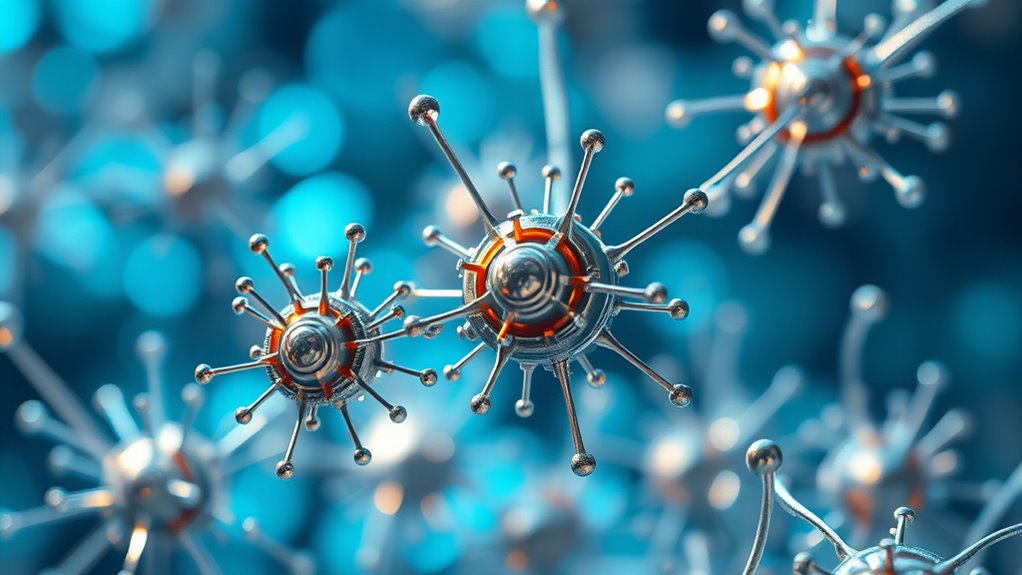
You’ll explore how nanomachines are classified and the various types used in medicine today. Advanced diagnostic tools rely on cutting-edge nanotechnology to detect diseases early and accurately. Understanding these devices helps you see their vital role in improving healthcare outcomes. For instance, dog names can be used to personalize nanomedical treatments, enhancing patient engagement and compliance.
Nanomachine Classifications and Types
Nanodevices in medicine can be classified into various types based on their design, function, and technological approach. You’ll find molecular machines, which operate at the atomic level to perform specific tasks like drug delivery or sensing. Nanorobots are larger, more complex devices capable of steering through bodily fluids to target tissues precisely. Nanoparticles serve as carriers for drugs, imaging agents, or both, enhancing treatment accuracy. Dendrimers are branched, tree-like structures used for drug delivery and gene therapy. Liposomes are spherical vesicles that encapsulate therapeutic agents, improving stability and targeting. Each type leverages different materials, mechanisms, and scales, enabling you to choose the most suitable nanomachine for specific medical applications. Understanding these classifications helps in designing effective, targeted nanomedical interventions.
Advanced Nanotech Diagnostic Tools
Advancements in nanotechnology have led to the development of sophisticated diagnostic tools that operate at the cellular and molecular levels. These nanodevices enable you to detect diseases earlier and more accurately than traditional methods. Quantum dots, for example, are fluorescent nanoparticles that help identify specific biomolecules, providing real-time imaging of cancer cells. Nanosensors can monitor biological signals like glucose or pH changes with high sensitivity, aiding in disease management. Lab-on-a-chip systems integrate multiple diagnostic processes into a single device, reducing time and sample volume needed. Additionally, nanorobots are being designed to seek out and analyze specific cellular environments. These tools revolutionize diagnostics by offering faster, more precise insights into your health, paving the way for personalized medicine and improved treatment outcomes. Cultural and Regional breakfast traditions have inspired the design of some nanomedical devices to better understand diverse biological environments across populations.
Applications of Nanomachines in Diagnostics and Imaging

Nanomachines are revolutionizing diagnostics by enabling more precise disease detection. They offer advanced imaging techniques that reveal details previously impossible to see. As a result, your ability to identify and monitor health conditions improves markedly. Additionally, vetted nanomachines ensure reliable and safe operation within medical settings.
Enhanced Disease Detection
How can tiny tools revolutionize disease detection? Nanomachines enable highly sensitive and early diagnosis by targeting specific biomarkers at the cellular level. Their small size allows them to circulate efficiently through the bloodstream and penetrate tissues, identifying disease signals with remarkable precision. These nanodevices can detect minute changes in molecular patterns, often before symptoms appear, leading to earlier intervention. They can also be engineered to respond to particular environmental cues, producing measurable signals that improve diagnostic accuracy. This early detection capability reduces false negatives and accelerates diagnosis timelines. By integrating nanomachines into diagnostic tools, healthcare providers gain access to faster, more reliable information, ultimately improving patient outcomes and enabling personalized treatment strategies.
Advanced Imaging Techniques
Advanced imaging techniques leverage nanomachines to achieve unprecedented levels of detail and specificity. These tiny tools can target and highlight specific cells or molecules, transforming diagnostics. With nanomachines, you can expect:
- Enhanced contrast agents that improve visibility of tumors or infections.
- Real-time tracking of cellular processes at a molecular level.
- Precise localization of disease markers, enabling early detection.
- Some nanomachines incorporate high suction power technology to assist in clearing pathways and improving imaging clarity.
Targeted Drug Delivery and Therapeutic Strategies
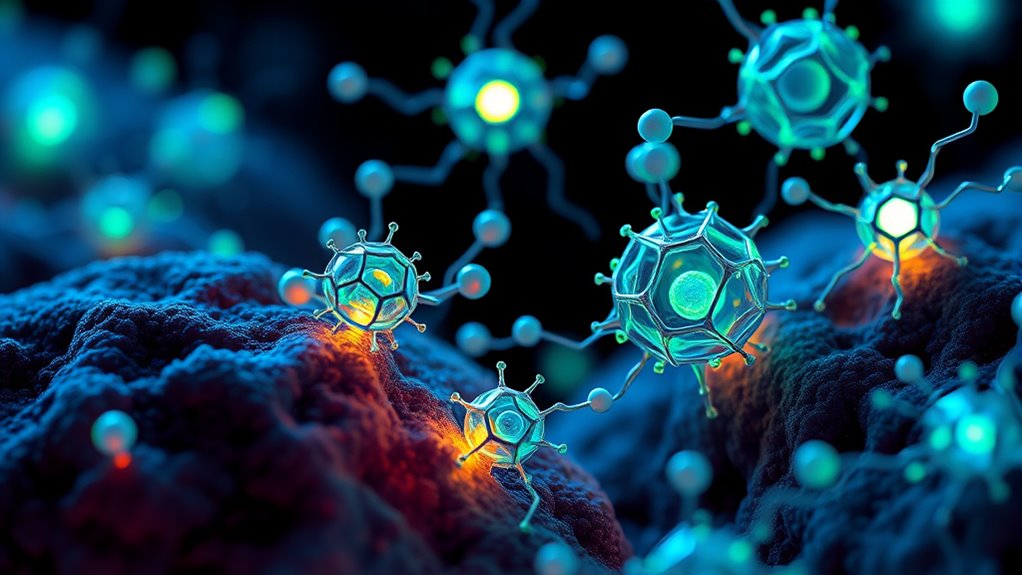
Have you ever wondered how modern medicine targets specific cells to improve treatment outcomes? Nanomedicine uses nanomachines like nanoparticles to deliver drugs directly to diseased cells, minimizing side effects. These tiny carriers can be engineered to recognize specific markers on target cells, ensuring precise delivery. Once they reach their destination, they release their therapeutic payloads, enhancing drug efficacy. Strategies include surface modifications that improve targeting accuracy and controlled release mechanisms for sustained effects. This approach allows for higher concentrations of medication at the disease site while reducing exposure elsewhere. As a result, treatments become more effective and less toxic. Color accuracy and contrast ratios are key factors in optimizing the performance of nanomedicine imaging techniques, enabling detailed visualization of targeted delivery. Targeted drug delivery exemplifies how nanotechnology transforms traditional therapies into smarter, more personalized solutions.
Challenges and Safety Considerations
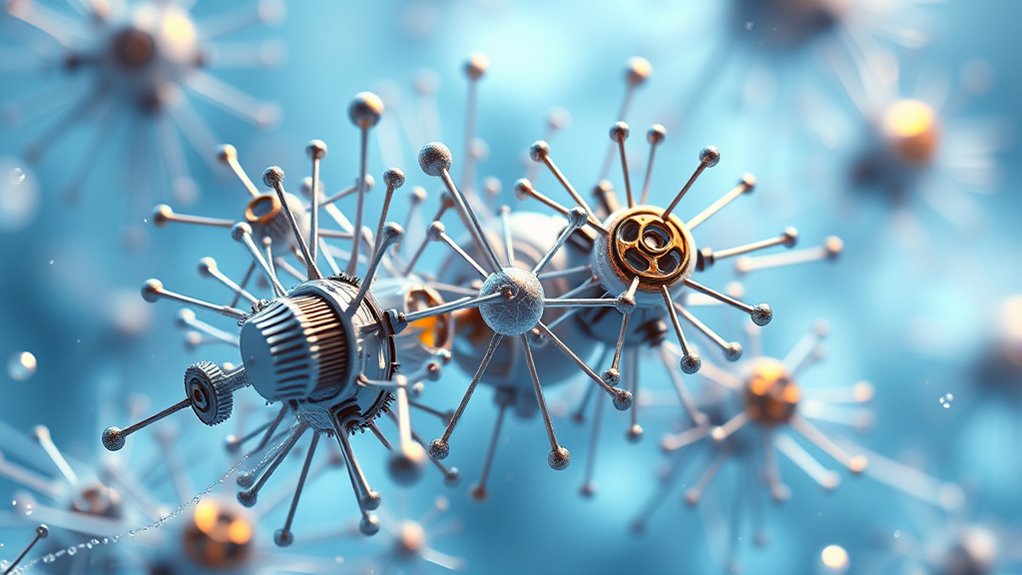
While targeted drug delivery via nanomedicine offers promising benefits, it also presents significant challenges and safety concerns that must be addressed. First, you need to contemplate potential toxicity; nanomaterials can accumulate in organs, causing unforeseen side effects. Second, there’s the issue of biocompatibility, as not all nanomaterials are compatible with human tissues, risking immune reactions. Third, controlling the behavior of nanomachines within the body is complex, making off-target effects a concern. Ensuring safe degradation and clearance of nanomaterials is essential to prevent long-term buildup. Additionally, regulatory frameworks are still evolving, which complicates approval processes. Addressing these challenges requires rigorous testing, clear guidelines, and ongoing safety evaluations to protect patients while harnessing nanomedicine’s full potential. Moreover, understanding self-watering plant pots can provide insights into passive water regulation mechanisms that could inspire safer nanomachine designs.
Future Perspectives and Emerging Trends
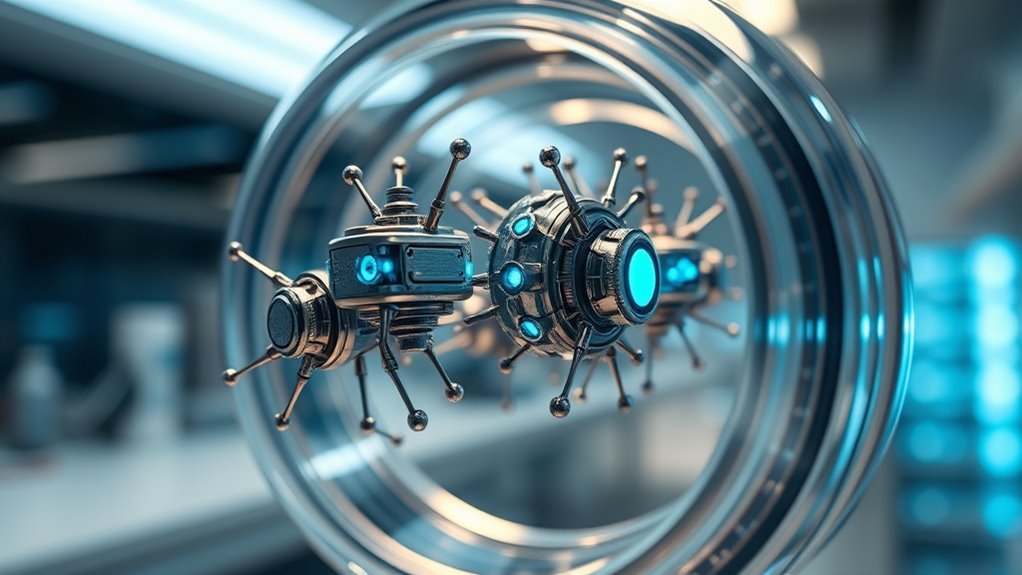
Emerging trends in nanomedicine are poised to revolutionize healthcare by enabling more precise, personalized treatments. Advances in targeted drug delivery will allow you to treat diseases at their source, minimizing side effects. The development of smart nanomachines capable of responding to environmental cues will enhance diagnostics and therapies. You can expect greater integration of nanotechnology with artificial intelligence, leading to real-time monitoring and adaptive treatment plans. Researchers are also exploring biodegradable nanomaterials, reducing long-term safety concerns. As regenerative medicine evolves, nanomachines could facilitate tissue repair and organ regeneration. These innovations will make treatments more efficient, less invasive, and tailored to individual needs. Staying informed about these emerging trends ensures you’re prepared for the transformative future of nanomedicine in healthcare. Understanding the properties of nanomaterials will be crucial for advancing these technologies safely and effectively.
Frequently Asked Questions
How Cost-Effective Are Nanomachines Compared to Traditional Medical Devices?
Nanomachines can be more cost-effective than traditional devices over time because they often require less material, reduce treatment durations, and improve precision, leading to fewer complications. While initial development and production costs may be high, their long-term benefits, such as decreased hospital stays and targeted therapy, make them a smart investment. As technology advances and scales up, expect nanomachines to become increasingly affordable and accessible in healthcare.
What Are the Ethical Implications of Using Nanomachines in Humans?
You should consider that using nanomachines in humans raises ethical concerns about safety, privacy, and consent. You might worry about unintended side effects or long-term health impacts, and whether patients truly understand the risks involved. Additionally, there are questions about who controls the technology and how it might be misused or lead to inequality. Addressing these issues requires careful regulation, transparency, and ongoing ethical discussions.
How Scalable Is the Production of Medical Nanodevices?
You can imagine producing medical nanodevices as building a city-sized factory, and it’s getting more scalable every day. Advances in manufacturing tech, like nanoscale lithography and self-assembly, make mass production possible. Though challenges remain, you’re on the brink of transforming healthcare with devices that could be snapped up in millions. As technology improves, scaling up becomes not just feasible, but inevitable, revolutionizing medicine worldwide.
Can Nanomachines Adapt to Different Diseases or Patient Conditions?
Yes, nanomachines can adapt to different diseases and patient conditions. Researchers design them with customizable features, allowing you to modify their functions for specific medical needs. They can be programmed to target various cell types or respond to unique biological signals, making treatments more personalized. This adaptability enhances their effectiveness across a broad spectrum of illnesses, ensuring you receive tailored therapies that improve outcomes and reduce side effects.
What Regulatory Frameworks Govern Nanomedicine Development Worldwide?
Think of regulatory frameworks as the guiding stars shaping nanomedicine’s future. Worldwide, agencies like the FDA in the U.S., EMA in Europe, and other national bodies set the rules. They scrutinize safety, efficacy, and ethical concerns, ensuring your innovations reach patients without unintended harm. While these standards vary, they all serve as the compass to navigate the complex, promising world of nanotechnology in healthcare.
Conclusion
As you explore nanomedicine, you’ll see how nanomachines revolutionize healthcare, offering precise diagnostics and targeted treatments. Did you know that the global nanomedicine market is projected to reach $350 billion by 2030? While challenges remain, ongoing innovations promise safer, more effective therapies. Embracing these advancements can profoundly improve patient outcomes, making nanomachines not just a breakthrough but a cornerstone of future medicine.
